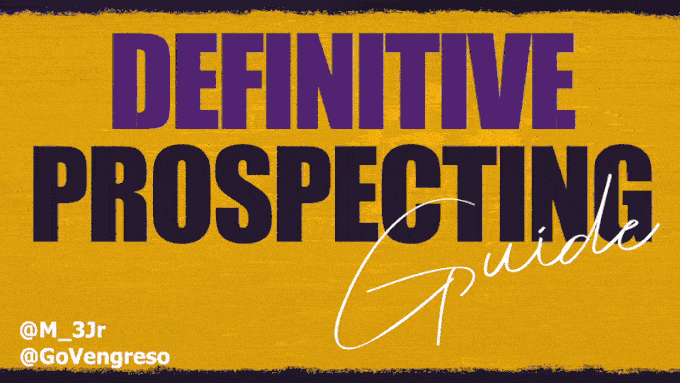Unlocking the power of sales might seem like a Herculean task, but with the right approach, it can become an achievable goal. Sales goes beyond merely selling products or services; it involves comprehending the desires of your customers and providing tailored solutions that meet their individual needs.
My most famous line as an influencer and that was used in the movie “The Story of Sales” was: “Sales is the Art of Helping.” That sums up the profession in six words!

I’ve spent 25 years in the industry, starting at the age of 19 years old when I got my first big break as a telemarketer (now called SDR) at a software organization. Within 6 months, I was promoted from a Telemarketer into a Jr. Account Executive. In that year, I learned from some of the greatest sales managers that I’m friends with today.
Prior to the age of 19, I worked in consumer sales at a retail shop known as Ritz Camera Centers. For those of us that are over the age of 45, we likely remember the 35mil film we used to take to various stores for processing. I worked as a photo finishing developer and got promoted to sales associate. I used the money I earned to pay for my entire first year of college. During my time there, I honed my ability to understand potential clients, analyze products thoroughly, and create innovative solutions that would persuade customers to make purchases while still on the premises.
This guide covers everything you need to know about sales, including important positions, methods, and tactics for success in our competitive industry.
Short Summary
- Sales is the activity of exchanging products or services for payment, with the goal of building trust with your buyers.
- Success in a selling role requires an educational background, experience, focus, tenacity and strong communication skills.
- Selling roles can be highly rewarding with the right support and training. They involve base salary plus commission payments and leverage various strategies such as consultative selling & account based sales to drive success.
What is Sales?

Sales can be defined as the activities related to the exchange of a product or service for a monetary value from a seller to a consumer or business. Sales are essentially the result of a mutually beneficial agreement between a seller offering a specific product or service, and a buyer who is eager to invest in said product or service.To finalize a sale, both parties must agree on the particulars of the transaction, such as price, quantity, delivery method, and delivery time.
The purpose of sales is to provide solutions for the customer which solve for a particular need or want. Successful sellers focus on understanding the customer’s needs and offering tailored solutions, rather than simply trying to convince them to buy. In this way, selling is about building trust and fostering long-term relationships with customers, ultimately leading to increased revenue and business growth.
How to Get Into a Sales Role?
To get into a sales role, one must have the right skills, experience, and attitude. In a B2B sales role, usually a Bachelor’s degree in business, marketing, or a related field, along with relevant sales experience, strong communication and interpersonal skills, and proficiency in MS Office and CRM practices are generally required. However, the same requirement doesn’t usually apply to direct sales roles or for outside sales representatives for product companies (i.e. door-to-door solar companies). Aspiring sales professionals should gain relevant experience and interpersonal skills while pursuing a Master’s degree in business administration or a related field to enhance their expertise and marketability.
Sales roles can be broadly categorized into two groups: inside sales and outside sales (also referred to as field sales). Additionally, there are roles such as business development, sales development, business-to-business (B2B) sales, business-to-consumer (B2C) sales, eCommerce sales, and direct selling.
Consultative selling and account-based sales are essential strategies for sales success, as they entail understanding a customer’s needs and providing solutions that fulfill them.
An interesting statistic is 50% of all college graduates go into a sales role straight out of college!
If your goal is to land a selling opportunity here are some ways you can get into a sales role:
- Check online job boards such as Indeed and Glassdoor.
- Attend job fairs and networking events.
- Contact recruitment agencies that specialize in sales positions.
- Search for sales job openings on company websites.
- Utilize social media platforms like LinkedIn to connect with recruiters and companies.
- Ask for referrals from employees at the target company, or friends, family, and colleagues in the sales industry.
- Check with professional sales organizations for job postings and resources.
- Attend industry conferences and events to network and learn about job opportunities.
- Reach out to sales managers directly through email or phone to inquire about job openings.
- Sign up for LinkedIn Premium and source the selling roles from the jobs board.
- Optimize your LinkedIn Profile so you can be found by someone using LinkedIn recruiter.
Is Sales Hard?

Sales can be a complex and challenging field, as professionals may encounter a variety of challenges, including competition, limited time for selling (aka admin time), lack of response from prospects, extended sales cycles, inadequate qualified inbound sales leads, and rejection. There is no doubt, whether you’re selling to consumers or businesses, salespeople take on the toughest roles out there.
Consider this: The success of a salesperson in meeting their quotas and selling a product not only affects their income, but also has an impact on crucial aspects of their life such as their mortgage payments, car expenses, any sudden accident expenses, health benefits, and even necessities like food. This is irrespective of outside influences like pricing pressure, buyer interest, purchase requirements, etc.
However, with the right training and support, sales can also be the most rewarding career choice that offers the satisfaction of helping customers, the potential for high earnings, the opportunity to build relationships, and the ability to work independently.
Ultimately, the key to success in sales lies in perseverance, resilience, and adapting to ever-changing market conditions, company changes and customer needs.
How are Sales Representatives Paid?
Sales representatives may be compensated through commission-based, salary-based, or a combination of both payment structures. The most common form of payment structure for sales compensation is the base salary plus commission plan. This plan ensures that sales representatives receive a stable base salary and extra financial motivation to encourage them to achieve or surpass their sales targets. For efficient payroll management, consider generating pay stubs to provide transparent and detailed information on earnings and deductions.
This compensation model ensures that sales representatives are rewarded for their performance, thus motivating them to excel in their roles and contribute to the company’s overall success.
However, there are many outside sales representatives that are commission-based only roles. This means you only get paid money for goods sold! I should also state that this is the payment model of a small business owner as well. I, too, have been on this plan when I first started my small business here at Vengreso. In other words, you eat what you kill.
Which Sales Jobs Pay the Most?
The highest paying sales jobs are often found in industries such as technology, pharmaceuticals, and consulting. Factors such as industry, experience, and location can all have an impact on a salesperson’s salary.
Other lucrative sales positions include consumer packaged goods sales, solar sales representative, and pre-sales systems engineer. It is essential for professionals seeking high-paying sales roles to continually develop their skills, network, and industry knowledge to stay competitive in the job market.
Types of Sales Functions

In the world of sales, there are several different approaches and techniques, each tailored to suit specific business needs and customer preferences. Understanding the various types of sales areas helps sales professionals determine which area is most suitable for them. It also helps companies identify which go-to-market motion they should take for marketing and selling their product or service to buyers. This ultimately leads to better results for both sellers and the company they represent.
Some of the most common types of sales include inside sales, outside sales, B2B, B2C, eCommerce, and direct selling. Each of these sales approaches has its unique characteristics, advantages, and challenges, which we will explore in more detail in the following sections.
Inside Sales vs. Outside Sales (aka Field Sales)
Inside sales is a remote sales approach in which virtual sales teams interact with prospects and customers from a remote office environment, working collaboratively with their team members. This can also be called virtual selling.
Outside sales, on the other hand, is a face-to-face sales approach where salespeople facilitate agreements with potential customers outside their organization.
Inside sales offers the benefit of time and cost savings, as well as more effective customer service and improved customer relationships, while outside sales allows for the establishment of personal connections with customers, fostering trust and loyalty, and providing direct customer feedback which can be used to refine the sales process.
Given that these two worlds blended during COVID, both of these roles in my opinion are now just part of the sales department and the salesperson focuses are often the same.
Business-to-Business (B2B) vs. Business-to-Consumer (B2C) Sales
B2B sales involve providing products and services to other businesses, which are typically more intricate and involve longer sales cycles, while B2C sales involve selling products and services to individual customers, which are generally less intricate and more transactional.
B2B sales are more reliant on personal relationships and trust-building, while B2C sales focus on catering to the preferences and needs of individual consumers. Additionally, B2B sales involve a smaller group of prospects, while B2C sales have a larger pool of potential customers, making each sales approach distinctive in its strategy and execution.
eCommerce Sales

eCommerce sales refer to the buying and selling of goods or services from clothing to picture frame materials, via electronic platforms, including websites, mobile apps, and social media. This type of sale allows businesses to reach a broader audience without the need for a physical store, and provides customers with the convenience of shopping from the comfort of their own homes. The marketing costs for these models generally are high. For businesses aiming to enhance their online presence and increase sales, utilizing effective tools such as free cross listing software can play a crucial role in optimizing product visibility across various platforms.
With the rise of the internet and the increasing popularity of online shopping, eCommerce sales have become an essential aspect of many businesses’ sales strategies. As a result, businesses are recognizing the need to adapt and stay competitive in the ever-evolving digital landscape by eCommerce replatforming, such as a PrestaShop to WooCommerce migration. It is thought that often times business growth comes from a product or service selling via an online store. Frankly, money exchanged through eCommerce transactions believe it or not still does not make up the majority of sales.
The Difference Between B2B Sales & Direct Selling
B2B sales typically involve larger transactions and extended sales cycles, while direct selling is commonly a transaction conducted on a smaller scale and entails selling directly to customers through a network of independent sales representatives. Direct selling is a commission-based, one-on-one selling approach, often used in industries such as cosmetics, nutrition, and household products.
Although B2B sales and direct selling share the fundamental aim of generating revenue, their individual strategies and techniques vary considerably. As a result, it is critical for sales experts to comprehend and adjust to the distinct needs of their particular sales setting.
What are the Different Sales Roles?

In sales, there are various roles and responsibilities, each requiring a unique set of skills and expertise to excel. Understanding the nuances of each sales role is essential for both employers looking to build a successful sales team and individuals seeking to advance their careers in sales.
Some of the most common roles include account executive, account manager, account director, client partner, sales development and business development representative. Each of these roles has specific responsibilities and focuses within the sales process, which we will explore further in the following subsections.
Business Development vs. Sales Development
Business development emphasizes long-term growth and strategy, whereas sales development focuses on generating short-term revenue. Business development representatives prioritize outbound leads and exploring new markets, while sales development representatives prioritize qualifying inbound leads and creating revenue for the organization. It should be stated that I have seen the exact opposite at many companies whereby the BDR manages inbound and the SDR manages outbound. Regardles of what the marketing or sales department may call the role, the skills don’t change – one focuses on inbound and one on outbound.
While both roles are essential for driving business growth, they require different skill sets and strategies to be successful. Business development involves activities such as market research, identifying potential customers, and creating partnerships, while sales development involves lead qualification, cold calling, and producing sales presentations.
Account Executive vs. Account Manager
Account executives are responsible for generating new business and managing existing accounts, while account managers focus on maintaining and growing existing accounts. Although both roles involve working closely with customers and providing tailored solutions, account executives typically possess more experience or education than account managers, and often have higher salaries. Compared to their account manager counterparts, solution sales representatives usually have a higher TTC or total target compensation and typically have a higher quota for selling new business.
By understanding the differences between these two roles, sales professionals can better align their skills and career goals with the right position.
Account Director vs. Client Partner
Account directors and client partners both play crucial roles in managing customer relationships and promoting sales. An account director oversees the account and ensures client satisfaction. A client partner guides and assists clients in achieving their business goals and increasing revenue.
Both roles involve understanding customer requirements and providing tailored solutions, but a client partner typically focuses more on providing counsel and assistance, whereas an account director focuses on managing the overall relationship and ensuring the client’s needs are met.
However, it should be noted that in many companies the account director is the same role as the client partner and often times there is no difference in the function or role.
Essential Sales Strategies for Insane Results

In today’s competitive sales landscape, it is vital for sales professionals to have a well-rounded arsenal of strategies to achieve success. By mastering essential sales strategies, individuals can increase their efficiency, close deals more effectively, and ultimately contribute to the growth and success of their organization.
Two essential sales strategies for success are consultative selling and account-based sales. Both of these strategies emphasize the importance of understanding the customer’s needs, building trust, and providing tailored solutions to achieve the desired outcome.
In the following subsections, we will delve deeper into each of these strategies and explore how they can be applied to achieve a sales plan, success and targets.
Consultative Selling
Consultative selling is a sales approach that emphasizes understanding the customer’s requirements and providing solutions that address those needs. It involves developing relationships with customers and providing them with tailored advice and assistance, rather than simply trying to persuade them to buy.
Consultative selling allows sales professionals to satisfy their customers’ specific needs by prioritizing the establishment of trust and long-term relationships, leading to higher customer satisfaction and loyalty.
During my time as a manager at a Fortune 16 company, I successfully handled numerous contracts and achieved over $100 million in closures, effectively managing and expanding the company’s accounts. I still vividly remember a moment when a CIO described the concept of “consultative selling.” He said, “It is when the salesperson can tell me what is happening with my competitors in the industry and identify what I must do to stay ahead of the competition to drive business growth.”
Account-Based Sales
Account-based prospecting is an approach to sales that concentrates on targeting particular accounts and cultivating relationships with key decision makers within those accounts. It necessitates comprehending the customer’s requirements and providing solutions that address those needs. By focusing on high-value accounts and formulating more customized sales strategies, account-based sales can lead to enhanced efficiency, improved customer relationships, and higher delivery and conversion rates. Account based sales should not be confused with account based marketing. While they go hand in hand, they are different.
This targeted and strategic approach to sales can help salespeople close deals more effectively and contribute to the overall success of their organization.
9 Common Sales Terms Defined
There are numerous terms and phrases that are commonly used by salespeople. Understanding these terms is essential for effective communication, collaboration, and overall success within the selling industry.
To help demystify the language of sales, we will define and explain nine common sales terms: prospect, deal, sales pipeline, sales plan, sales forecasting, sales mindset, sales cycle, sales pitch, and social selling. By familiarizing yourself with these terms, you can enhance your sales vocabulary, create more effective selling techniques, stronger sales etiquette and gain a deeper understanding of the sales process.
-
Prospect
A prospect is an individual or organization (buyer) that a salesperson has identified as a potential customer for their products or services. Prospects are typically identified through various methods, such as sales referrals, networking, or marketing campaigns, and are considered a crucial part of the sales pipeline. They can come as an inbound lead or as an outbound targeted campaign.
Salespeople can increase revenue and growth for their organization by finding and connecting with potential customers, then converting them into actual buyers.
I created this prospecting guide for your review. It is the longest blog on our website and takes you through every phase of how to prospect.
-
Deal
In sales, a deal is a mutually beneficial agreement between a buyer and seller to exchange goods or services for a specified price. The stages of a deal include lead nurturing, first contact, assessing the prospect’s requirements, presenting solutions, addressing objections, and requesting the sale.
Closing the deal is a pivotal step in the sales process, as it determines the success of the transaction and ultimately contributes to the overall revenue and growth of the company.
-
Sales Pipeline
A sales pipeline is a visual representation of the steps taken to guide a prospective buyer through the sales funnel. It displays each stage from lead prospecting to the final sale and is a useful tool for converting leads into sales. Sales leadership can use this visual representation to monitor the various stages of the sales process, ensuring that leads are progressing efficiently and effectively through the pipeline.
By effectively managing the sales pipeline, sales professionals can optimize their sales process and achieve greater success in their roles. There is no doubt that this is the role of sales effectiveness teams or also known as a sales enablement function.
I recommend that you glean some powerful insights on how to build a sales pipeline from this guide here:
-
Sales Plan
A sales plan is a strategic document that outlines the goals, objectives, and strategies for a company’s sales team. It serves as a roadmap for the sales team to follow in order to achieve their targets and drive revenue growth.
A sales plan typically includes a detailed analysis of the target market, competition, and customer needs. It also outlines the sales team’s responsibilities, sales targets, and the strategies they will use to reach those targets.
Additionally, a sales plan includes a timeline and budget for implementing the strategies. Overall, a sales plan is a crucial tool for any small business or large enterprise looking to effectively manage and improve their sales performance.
We recommend that you read this article and listen to this very informative podcast on this very topic.
-
Sales Forecasting
Sales forecasting is a crucial aspect of business planning. It involves estimating future sales based on historical data, market trends, and other relevant factors. By accurately predicting sales, companies can make informed decisions regarding production, inventory management, and resource allocation, with the assistance of inventory management software that provides real-time insights to optimize their supply chain operations. Sales forecasting helps businesses set realistic goals, identify potential challenges, and develop effective strategies to maximize revenue and profitability.
There are several methods used in sales forecasting. One common approach is the time series analysis, which involves analyzing historical sales data to identify patterns and trends. This method assumes that past sales patterns will continue into the future. Another method is the market research approach, which involves gathering data on customer preferences, market conditions, and competitor activities to predict future sales. Additionally, companies may use a combination of qualitative and quantitative techniques to forecast sales, such as expert opinions, product surveys, and statistical models.
Sales forecasting is not without its challenges. Factors such as seasonality, price, economic conditions, and unexpected events can impact sales projections. It is important for businesses to regularly review and update their sales forecasts to account for any changes in the market. Companies can enhance their ability to meet customer demands and hit sales targets by being responsive to market dynamics. This can be achieved through continuous monitoring and fine-tuning of their forecasts, allowing for greater agility and a better ability to adapt to changing conditions.
To read the entire guide to sales forecasting and learn how to master this click here:
-
Sales Mindset
A sales mindset is a powerful tool for achieving success in the world of business. It is a mindset that is focused on achieving sales goals, generating revenue, and building strong relationships with customers. A top salesperson’s mindset is characterized by a positive attitude, persistence, and a strong belief in the value of the products or services being sold. It is about being proactive, taking initiative, and constantly seeking out new opportunities to sell. With a sales mindset, one is always looking for ways to improve, learn, and grow in order to become a more effective salesperson. So, if you want to excel in sales, embrace a sales mindset and watch your success soar.
-
Sales Cycle
The sales cycle is a crucial process in any business. It refers to the series of steps that a potential customer goes through before making a purchase. It starts with awareness, where the prospective customer first becomes familiar with the product or service. Then comes consideration, where the customer evaluates different options. Finally, there is the decision stage, where the customer makes the purchase. Understanding the sales cycle is essential for businesses to effectively target and convert customers. If you want to boost your sales, make sure to optimize each stage of the sales cycle and provide a seamless customer experience.
Every sales organization describes the selling process in different phases. For the sake of argument, consider the spectrum to be from pre-hello to hello and hello to close. Whether your sales teams are outside sales representatives, direct sales, sales associates in consumer product goods, inside sales or a small business salesperson needs to understand the sales cycle of how a buyer will make a purchase. In this way, you’ll understand when to take interest and how to drive that into a purchase!
-
Sales Pitch
A sales pitch is the art of persuading potential customers to buy a product or service. It involves effectively communicating the value and benefits of the offering in a concise and compelling manner. A well-crafted sales pitch captures attention, addresses customer needs, and creates a sense of urgency to take action. It is a powerful tool for driving business growth and building customer relationships.
Ready to master the art of the sales pitch? Let’s get started by reviewing this guide on the perfect sales pitch.
-
Social Selling

Social selling is a powerful technique that every sales person should master. It involves leveraging social media platforms to build relationships with consumers, engage with potential customers, and ultimately drive sales.
In today’s digital age, social selling is essential for staying competitive and reaching a wider audience, and it gives marketing a huge competitive advantage. By understanding how to effectively use social media marketing for selling, sales people can tap into the vast potential of online networks, connect with prospects, and establish trust and credibility. It allows for personalized and targeted interactions, enabling sales professionals to provide value and address customer needs in a more meaningful way. So, if you want to boost your sales game and stay ahead of the curve, it’s time to embrace social selling and unlock its tremendous benefits.
Take action today and start harnessing the power of social media to drive your sales success and yes don’t worry we have a guide to social selling right here for you!
Building and Managing an Effective Sales Team
Building and managing an effective sales team is a crucial aspect of any successful organization. A highly skilled sales team has the power to boost revenue, cultivate customer loyalty, provide an exceptional delivery experience, and play a significant role in the overall expansion and triumph of the company.
To build and manage an effective sales team, it is important to hire the right sales representatives and provide them with the necessary training and development opportunities. In the following subsections, we will discuss the key aspects of hiring and training a successful sales team, and provide insights into how organizations can create a winning sales force and sales culture.
Hiring the Right Sales Representative
Hiring the right sales representatives is crucial for building a successful sales team. When imagining the perfect candidate, it is crucial to take into account the essential skills and expertise needed to thrive in the position, the personality traits that will harmonize well with the team, and the values that align with the company’s mission and culture.
An engaging job description should provide a concise overview of the role, list the associated responsibilities, outline the desired qualifications, and detail the benefits of the position. Posting on job boards and seeking referrals through various methods can help employers attract top talent and build a strong sales team.
Hiring is as much of an art as it is a science. I highly recommend you consider this guide to sales hiring for further assistance and support.
Training and Development
Providing training and development opportunities for sales representatives is essential for equipping them with the skills and knowledge required to excel in their roles. Corporate sales training and development activities can include on-the-job training, classroom instruction, virtual sales training with online courses, simulations, LinkedIn Training, LinkedIn Sales Navigator training and mentoring.
Investing in the ongoing professional growth of sales staff is paramount for organizations to guarantee their representatives have the skills and knowledge necessary to communicate effectively with clients, recognize their unique requirements, and offer customized solutions that increase earnings and customer contentment.
Navigating the Sales Process: From Prospecting to Closing

Navigating the sales process from prospecting to closing is a critical aspect of any successful sales strategy. By effectively guiding prospects through each stage of the sales funnel, sales professionals can increase their chances of closing deals and contributing to the overall success of their organization.
In this section, we will explore the key aspects of navigating the sales process, including identifying prospective customers and managing the sales pipeline. By mastering these essential components of the sales process, sales professionals can optimize their approach and achieve greater success in their roles.
Identifying Prospective Customers
Identifying prospective customers is the first step in the sales process. Sales professionals can employ various methods to identify potential customers to sell to, such as market research including various market research types , customer surveys, and data analysis. Additionally, sales professionals may leverage their networks and contacts to identify potential customers and expand their reach.
By effectively identifying prospective customers and understanding their needs, sales professionals can better tailor their approach and increase their chances of closing deals.
Managing the Sales Pipeline

Managing the sales pipeline is a crucial aspect of the sales process. It involves tracking and analyzing leads, managing customer interactions, and forecasting sales revenue. Sales professionals can collect data on leads, such as contact information, interests, and buying habits/interests, to track and analyze their progress through the sales pipeline. Sales managers should also ensure their team members know how to leverage buyer-level intent data as well.
Utilizing technology, such as CRM and sales automation tools, can help streamline the sales process and ensure leads are progressing efficiently through the pipeline. By effectively managing the sales pipeline, sales professionals can optimize their sales process and achieve greater success in their roles.
Here are 10 ways sales managers, directors or VP’s can streamline managing the sales pipeline more efficiently.
- Regularly review and update the sales pipeline to ensure accuracy and identify any potential gaps or bottlenecks.
- Provide ongoing training and support to the sales team to help them effectively manage and move deals through the pipeline.
- Implement a clear and standardized sales process that outlines the steps and milestones for each stage of the pipeline.
- Foster open communication and collaboration within the sales team to share insights and best practices for managing the pipeline.
- Utilize CRM software to track and analyze sales data, allowing for better forecasting and decision-making.
- Set clear sales targets and goals for the team, providing motivation and accountability.
- Regularly meet with individual sales reps to discuss their pipeline and provide guidance and sales coaching.
- Conduct regular pipeline reviews with the entire sales team to identify any potential issues or areas for improvement.
- Continuously monitor and evaluate the sales pipeline to identify trends and make data-driven adjustments as needed.
- Encourage and incentivize the sales team to prioritize accurate and timely updates to the pipeline.
Leveraging Technology in Sales
In today’s technology-driven world, leveraging technology in sales is essential for achieving success and staying competitive. By utilizing software tools and data analysis, sales professionals can streamline their sales processes, gain insight into customer behavior, and enhance communication with customers.
In this section, we will explore the various ways in which technology can be leveraged in sales, including the use of CRM, sales automation tools, and ChatGPT. Sales professionals can enhance their productivity, improve deal closure rates, and drive organizational growth and success by comprehending and leveraging the potential of such technologies.
I wanted to point out that we have created a few very rich guides on sales tools. I have attached them here for your reference and I encourage you to deep dive on each of them. Whether you’re a small business, salesperson, sales manager or in marketing, understanding these tools to engage a buyer or help sellers succeed in their skills of engaging with clients and eliminating productivity loss is the key focus.
Sales tools guides for your reference:
- How to Calculate the ROI of Your Sales Tools
- 10 Critical Sales Enablement Tools
- The Best Sales Prospecting Tools
- Social Selling Tools to Help Your Team Grow
- 6 Essential Remote Selling Tools for Massive Business Growth
- 35 Productivity Tools to Help You Win
- 20 of the Best Productivity Apps to Create Efficiency
CRM for Sales Success
Customer Relationship Management (CRM) systems are essential tools for achieving scale and growth. CRM’s help sales professionals maintain a centralized database, manage communication and interactions with prospects, enhance customer service, and share information across the sales team. In addition, CRM’s can help a seller leverage intent data, thereby allowing a seller to focus on a real buyer ready to buy your specific product, or service.
By effectively utilizing CRM for sales success, sales professionals can foster stronger customer relationships, increase efficiency, and ultimately drive revenue growth for their organization.
Sales Automation Tools
Sales automation tools are software or technology designed to streamline the sales prospecting process by automating repetitive tasks, such as sending follow-up emails, creating drip campaigns, or assigning tasks based on predefined rules. Notable sales automation tools include FlyMSG the Text Expander, HubSpot Sales Hub, Salesloft, Outreach, Salesforce’s Sales Cloud Account Engagement, etc.
By leveraging these types of sales automation tools, salespeople can save time, reduce the risk of human error, and focus on more meaningful tasks, such as building relationships with customers and closing deals.
How to Use ChatGPT in Sales

ChatGPT, an AI chatbot developed by OpenAI, utilizes natural language processing to generate conversational dialogue that resembles human interaction. ChatGPT can play a vital role in sales by automating various customer service tasks. It proves exceptionally useful in promptly addressing customer inquiries, offering comprehensive product information, and efficiently aiding customers throughout their order process. It can also help with writing emails including but not limited to sequences We recommend FlyMSG as the best writing assistant tool to help you. Of course if you’re looking for AI writing assistants, we’ve got that list complied for you here too.
Implementing ChatGPT in sales can lead to cost savings, enhanced customer satisfaction, and increased operational efficiency. By leveraging ChatGPT in sales, organizations can provide personalized and efficient customer service, ultimately driving revenue growth and customer loyalty.
Here are 20 of the Best ChatGPT Prompts for Sales.
Types of Sales Methdologies
If you want to run a successful sales organization, you have to have a solid sales process in place. No ifs, and, or buts about it. Lucky for you, there are a bunch of different sales methodologies out there that sales departments use to get the job done.
Our favorite methodology, of course, is the PVC Sales Methodology. Admittedly, it covers just the method by which you should engage a buyer through sales messaging. Thus, the value that all the other sales methodologies bring to the table.
Here are some of the top ones that I’ve seen work wonders. Take notes!
- Solution Selling: Solution selling is when the salesperson leads the conversation with the benefits that a product, service or solution will give the buyer or prospective client. This method acknowledges that prospects are informed decision makers and have done their research.
- SPIN Selling: SPIN is centered on the four types of questions salespeople should ask their prospective clients. They are focused on: Situation, Problem, Implication, and Need-Payoff. The focus questions identify the prospect’s pain points and help the salesperson build rapport with the buyer.
- N.E.A.T. Selling: This is a framework that’s used to qualify leads. N.E.A.T. stands for: needs, economic impact, access to authority, and timeline.
- Conceptual Selling: Conceptual selling originally developed by the Miller Heiman Group and is a method where salespeople understand the customer’s needs and goals and present a solution that aligns with those needs and goals. Rather than simply promoting product or service, conceptual selling aims to establish a deeper understanding of the customer’s business and, and how the proposed solution can help overcome those challenges and achieve their desired outcomes.
- SNAP Selling: SNAP selling developed by my friend Jill Konrath is an acronym for: Keep it Simple, be iNvaluable, always Align, and raise Priorities.
- GAP Selling: Gap selling is a sales methodology developed by Keenan, the CEO of A Sales Guy Inc. It focuses on identifying the gap between the current state of the prospect and their desired state.
- The Challenger Sale: The Challenger Sale follows a teach-tailor-take control process. Salespeople teach the prospect, tailor their communications, and take control of the sale. The Challenger Sale is a sales approach developed by Matthew Dixon and Brent Adamson, which suggests that successful salespeople are those who challenge their customers’ way of thinking and drive them toward a better solution.
- Customer Centric Selling: Customer centric selling is an approach where the needs and preferences of the customer are the forefront of the sales process. It focuses on building strong relationships with and understanding their individual requirements. This approach requires a thorough understanding of the customer’s industry, their pain points, and how your product or service can address those pain points. The key to successful customer-centric selling is listening to the customer and tailoring your offering to meet their specific needs.
- MEDDIC: Meddic Selling is a structured sales methodology that is commonly used by technology companies to effectively sell complex products or solutions. The term “meddic” stands for Metrics, Economic Buyer, Decision Criteria, Decision Process, Identify Pain, and Champion.
Summary
In conclusion, the world of consumer or business sales is vast and complex, with numerous roles, strategies, and techniques for success. By understanding the different types of sales, mastering essential sales strategies, and leveraging technology, sellers can achieve greater results and contribute to the overall growth of their organization.
As you embark on your journey toward sales success, remember that the key to unlocking the power of sales lies in understanding your customers, building trust, and providing tailored solutions that cater to their specific needs. With perseverance, resilience, and a willingness to adapt, you can conquer the challenges of the sales world and reap the rewards of a fulfilling and lucrative career.
Frequently Asked Questions

What is the definition of sales?
Sales are the exchange of goods and services for money or other compensation. It involves a customer purchasing a product or service from a business, which results in revenue for the company.
Sales can be achieved through many different channels including online, channel partnerships, via affiliates, in stores, or through sales teams.
What are common types of sales?
Sales come in all shapes and sizes, but the five most common types of sales are Transactional, Solution, Consultative, Provocative, and Collaborative. Each offers unique benefits and drawbacks, and can play an important role in any successful sales strategy.
Transactional sales involve a single transaction, with the customer buying a product or service with no further commitment. Solution sales involve a more complex process, with the customer buying a solution to a problem. Consultative sales involve a more in-depth process.
What is the best sales podcast to listen to for training and education?
In my opinion, there are so many good ones. However, there is one that we believe stands out at the top as the best sales podcast and that is The Modern Selling Podcast.
How can you create diversity in sales?
We got you covered on diversity in sales too! One of my favorite blogs that I hosted is on this very topic. Listen in.
What are the best sales books I should consider reading?
We’ve also got you covered there too! I’ve created 55 of the best sales books for your reading pleasure!










